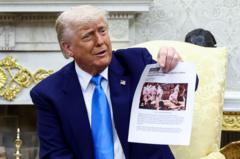In what many are calling a carefully staged diplomatic clash, South African President Cyril Ramaphosa faced off against U.S. President Donald Trump during a recent Oval Office meeting that took a sharp turn toward controversy. The meeting, part of diplomatic discussions, saw Trump leveraging claims of "white genocide" in South Africa, an assertion that sparked tense exchanges between the two leaders.
As the meeting progressed, Trump seized the moment to air a video that purportedly showcased inflammatory rhetoric from various South African political figures regarding white farmers. He asked an aide to "turn the lights down," creating a sensational atmosphere that many observers have likened to previous confrontational encounters with foreign dignitaries, such as Ukrainian President Volodymyr Zelensky.
Throughout the meeting, Ramaphosa was restrained, responding to Trump's inquiries with measured responses that sought to emphasize the need for dialogue and understanding. He urged Trump to listen to the voices of South Africans, countering the president's allegations about persecution with the assertion that no government-backed policy aimed at persecution exists. Trump's claims appeared to hinge on misunderstandings about land reform policies in South Africa, including a recent law permitting land seizures without compensation that has yet to be enacted.
In a diplomatic maneuver that seemed to cushion him from Trump’s aggression, Ramaphosa brought notable South African figures, including golf champions Ernie Els and Retief Goosen, into the room. Although this move added a unique layer to the meeting, it was clear that Ramaphosa's strategy was to draw attention away from the more provocative topics being discussed.
Ramaphosa's comments did include implicit criticisms of Trump's framing of South African politics. He highlighted the presence of the two golfers and an Afrikaner billionaire in the delegation to contest the narrative that there is a widespread genocide. Maintaining his composure, Ramaphosa did not engage fully with Trump's assertions, allowing the provocations to dissipate without direct confrontation.
This negotiation style indicates a growing sophistication in how some world leaders are adapting to Trump’s performative approach to diplomacy, which appears as much aimed at energizing his domestic political base as it is at resolving international issues. Ultimately, Ramaphosa's ability to maintain grace under pressure during a heated discussion may reflect a new paradigm in dealing with unpredictable political interactions, as both parties reconsider the balance between public display and substantive dialogue.


















